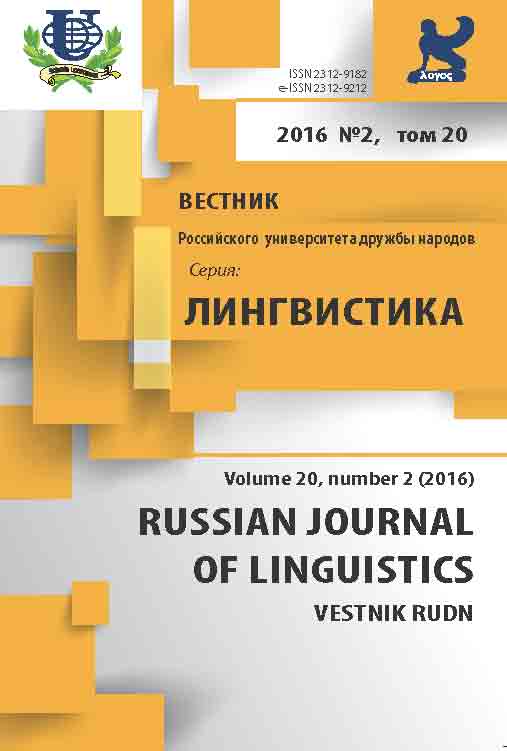Псевдокоммуникация vs квазикоммуникация
- Авторы: Черничкина Е.К.1, Лунева О.В.2
-
Учреждения:
- Волгоградский государственный социально-педагогический университет
- Волгоградский государственный институт искусств и культуры
- Выпуск: Том 20, № 2 (2016)
- Страницы: 77-90
- Раздел: Статьи
- URL: https://journals.rudn.ru/linguistics/article/view/14707
- ID: 14707
Цитировать
Полный текст
Аннотация
Статья посвящена анализу таких специфических форм общения, как квази- и псевдокоммуникация. Уточняется понимание данных терминов, которые иногда используются как взаимозаменяемые. Цель проведенного исследования, представленного в данной статье, - обнаружить и описать существующие различия и сходства рассматриваемых коммуникативных феноменов на основе теоретического и эмпирического анализа исследуемого материала на русском и английском языке. Материалом исследования являются фрагменты художественной коммуникации, скрипты фильмов, анекдоты, газетные публикации, картотека записи устной речи на русском и английском языках. В своей работе авторы опираются на следующие методы исследования: метод дефиниционного анализа (с помощью которого был уточнен терминологический аппарат исследования), метод лингвистического наблюдения и интроспекции (для отбора коммуникативных ситуаций), описательно-аналитический метод и метод сопоставительного анализа (для выявления сходства и различия исследуемых явлений), а также конверсационный анализ, позволивший проследить результативность общения, и др. Авторы рассматривают коммуникативные характеристики и анализируют причины появления и распространения на современном этапе этих форм общения. Предлагается классификация возможных форм их реализации в разных дискурсах. Псевдокоммуникация и квазикоммуникация характеризуются фиктивностью общения и определенным нарушением коммуникативной модели. При псевдообщении имеет место смысловой диссонанс кодируемой и декодируемой информации. В качестве основных параметров выделения подвидов псевдокоммуникации предлагаются полнота понимания, интенциональность и этап коммуникативного действия, где происходит коммуникативный сбой. Подчеркивается необходимость отличать случаи псевдообщения от фатической и непрямой коммуникации. Квазикоммуникация характеризуется отсутствием реального партнера и адекватной обратной связи. По мнению авторов, любой вид коммуникации может принимать форму квазиобщения. Предварительные результаты сопоставительного анализа показали, что данные типы коммуникации в равной степени свойственны как русскому, так и английскому коммуникативному поведению. Авторы подчеркивают значимость и перспективу изучения и научного анализа этих явлений с позиции коммуникативистики и лингвоэкологии, в том числе в сопоставительном аспекте, что может представлять научный интерес для лингвистов, а также и для специалистов по теории межкультурной коммуникации.
Об авторах
Елена Константиновна Черничкина
Волгоградский государственный социально-педагогический университет
Email: ekch@mail.ru
пр. Ленина, 27, Волгоград, Россия, 400066
Оксана Валерьевна Лунева
Волгоградский государственный институт искусств и культурыул. Циолковского, 4, Волгоград, Россия, 400001
Список литературы
- Винокур Т.Г. Говорящий и слушающий. Варианты речевого поведения. М., 1993.
- Дементьев В.В. Непрямая коммуникация и ее жанры. Саратов: Изд-во Сарат. ун-та, 2000.
- Дементьев В.В. Основы теории непрямой коммуникации: автореф. дис.. д-ра филол. наук. Саратов, 2001.
- Дридзе Т.М. Текстовая деятельность в структуре социальной коммуникации. М., 1984.
- Грейдина Н.Л. Невербальные лингвокультуремы в плоскости межкультурной коммуникации // Россия и Запад: диалог культур. 2014. № 7.
- Лакофф Дж. Прагматика в естественной логике // Новое в зарубежной лингвистике. М., 1985. Вып. 16: Лингвистическая прагматика. С. 439-471.
- Ларина Т.В. Категория вежливости в английской и русской коммуникативных культурах. М., 2003.
- Леонтович О.А. Механизмы формирования комического в межкультурной коммуникации // Аксиологическая лингвистика: игровое и комическое в общении: Сб. науч. тр. / Под ред. В.И. Карасика, Г.Г. Слышкина. Волгоград: Перемена, 2003.
- Макаров М.Л. Основы теории дискурса: монография. М.: ИТДГК «Гнозис», 2003.
- Норман Б.Ю. Псевдовысказывания как дидактический и лингвокультурный феномен // Вопросы русского языкознания: cб. науч. статей. М.: Изд-во Моск. ун-та, 2005. Вып. ХII: Традиции и тенденции в современной грамматической науке (по материалам Международного конгресса исследователей русского языка: «Русский язык: исторические судьбы и современность». С. 36-45.
- Петрова Т.И. Инсценированный квазидиалог как особый жанр детской речи (на материале речи детей 6-8 лет): Автореф.. дис. канд. филол. наук. Владивосток, 2000.
- Пономарева И.В. Псевдокоммуникация как результат нарушения принципов вербального общения // Фундаментальные исследования. 2013. № 6-4. С. 1028-1031.
- Почепцов Г.Г. Фатическая метакоммуникация // Семантика и прагматика синтаксических единств. Калинин, 1981.
- Федотова Л.Н. Социология массовой коммуникации. М.: Издательский дом Международного университета в Москве, 2009.
- Фенина В.В. Речевые жанры small talk и светская беседа в англо-американской и русской культурах: Автореф. дис.. канд. филол. наук. Саратов, 2005.
- Черничкина Е.К. Концепция искусственного билингвизма в теории языка: монография. Волгоград: Изд-во ВГПУ «Перемена», 2007.
- Цой Л.Н. Проблемы формирования конфликтологической компетенции управленческих кадров: от теории к практике // Материалы научно-практической конференции «Экстремальные ситуации, конфликты и социальное согласие». М.: Академия управления МВД России и «Институт социологии РАН», 1999.
- Якобсон Р. Избранные работы. М., 1985.
- Вerger Charles R. Interpersonal communication: Theoretical Perspectives, Future Prospect // Journal of communication. September 2005. Vol. 55. No 3. P. 415-447.
- Holmes J. Small talk at work: potential problems for workers with an intellectual disabitity // Research on Language and Social Interaction. 2003. 36 (1).
- Hymes D. Foundations in Sociolinguistics. An ethnographic approach. Philadelphia, 1974.
- Grice H.P. Utterer’s Meanings and Intentions // Philosophical Review. 1969. Vol. 78. P. 147-177.
- Griffin E.A. A first look at communication theory / Em Griffin; special consultant, Glen McClish. McGraw-Hill, 2000.
- Littlejohn S.W. Theories of Human Communication (7th ed.). Belmont, CA: Wadsworth, 2002.
- Schneider К.Р. Small Talk: Analysing Phatic Discourse. Marburg: Hitzeroth, 1988.
- Trenholm Sarah. Interpersonal Communication / Sarah Trenholm (Ithaca College), Arthur Jensen (Syracuse University). Wardsworth Publishing House. 4-th edition. Copyright 2000 by Wadsworth. A Division of International Thomson Publishing Inc.
Дополнительные файлы















